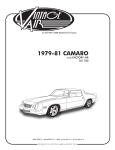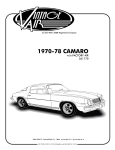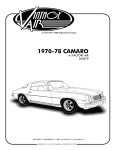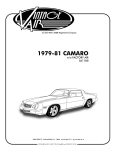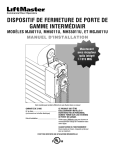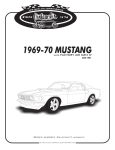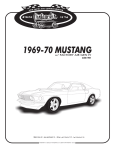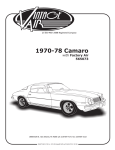Download Vintage 551170 Specifications
Transcript
an ISO 9001:2008 Registered Company 1969-70 MUSTANG WITHOUT FACTORY AIR 551170 901271 REV D 7/14/14, 1969-70 MUSTANG wo AC EVAP INST PG 1 OF 26 Table of Contents PAGES 1. 2. 3. 4. 5. 6. 7. 8. 9. 10. 11. 12. 13. 14. 15. 16. 17. 18. 19. 20. 21. 22. 23. 24. 25. 26. COVER TABLE OF CONTENTS PACKING LIST/ PARTS DISCLAIMER INFORMATION PAGE WIRING NOTICE ENGINE COMPARTMENT / PASSENGER COMPARTMENT FIGURES 1 & 2 DEFROST DUCT / FRESH AIR CAP & DRIVER AND PASSENGER SIDE LOUVER INSTALLATION FIGURES 3 & 4, 4a EVAPORATOR INSTALLATION FIGURES 5,5a & 6 FIREWALL COVER INSTALLATION FIGURES 7 & 7a CENTER LOUVER INSTALLATION FIGURES 8 & 8a DRAIN HOSE INSTALLATION & LUBRICATING O-RINGS, STANDARD HOSE KIT & MODIFIED A/C HOSE KIT FIGURES 9 & 10 HEATER HOSE & HEATER CONTROL VALVE INSTALLATION FIGURE 11 A/C & HEATER HOSE ROUTING FIGURE 12 FINAL STEPS & GLOVE BOX INSTALLATION FIGURES 13 & 13a DUCT HOSE ROUTING FIGURE 14 EVAPORATOR HARD LINE AND BRACKET INSTALLATION FIGURE 15 WIRING DIAGRAM GEN IV WIRING CONNECTION INSTRUCTIONS OPERATION OF CONTROLS. TROUBLE SHOOTING TROUBLE SHOOTING CONT. DRIVER SIDE LOUVER TEMPLATE PASSENGER SIDE LOUVER TEMPLATE CENTER LOUVER TEMPLATE FIREWALL COVER HOLE TEMPLATE EVAPORATOR KIT PACKING LIST 2 901271 REV D 7/14/14, 1969-70 MUSTANG wo AC EVAP INST PG 2 OF 26 EVAPORATOR KIT 551170 EVAPORATOR KIT PACKING LIST NO. 1. 2. QTY. PART NO. 1 1 763069 781069 DESCRIPTION GEN IV 4 VENT EVAP. SUB CASE w/ 207 ECU 1969-70 MUSTANG wo AC GEN IV ACC. KIT ** BEFORE BEGINNING INSTALLATION OPEN ALL PACKAGES AND CHECK CONTENTS OF SHIPMENT. PLEASE REPORT ANY SHORTAGES DIRECTLY TO VINTAGE AIR WITHIN 15 DAYS. AFTER 15 DAYS, VINTAGE AIR WILL NOT BE RESPONSIBLE FOR MISSING OR DAMAGED ITEMS. 1 GEN IV 4 VENT EVAP SUB CASE w/ 207 ECU 763069 2 F A N ACCESSORY KIT 781069 DASH COLD FLR DEF HOT NOTE: IMA GES MA Y NOT DEPICT ACTUAL PARTS AND QUANTITIES. REFER TO PACKING LIST FOR ACTUAL PARTS AND QUANTITIES. 3 901271 REV D 7/14/14, 1969-70 MUSTANG wo AC EVAP INST PG 3 OF 26 Important Notice—Please Read For Maximum System Performance, Vintage Air Recommends the Following: Heater Hose (Not Included With This Kit): Heater hose may be purchased from Vintage Air (Part# 31800-VUD) or your local parts retailer. Routing and required length will vary based on installer preference. Bolts Passing Through Cowl and/or Firewall: To ensure a watertight seal between the passenger compartment and the vehicle exterior, for all bolts passing through the cowl and/or firewall, Vintage Air recommends coating the threads with silicone prior to installation. Safety Switches: Your Vintage Air system is equipped with a binary pressure safety switch. A binary switch disengages the compressor clutch in cases of extreme low pressure conditions (Refrigerant Loss) or excessively high head pressure (406 PSI) to prevent compressor damage or hose rupture. A trinary switch combines Hi/Lo pressure protection with an electric fan operation signal at 254 PSI, and should be substituted for use with electric fans. Compressor safety switches are extremely important since an A/C system relies on refrigerant to circulate lubricant. Service Info: Attention: The following system components are capped: Compressor, evaporator, condenser & drier. Caps may be under pressure with dry nitrogen. Be careful removing caps. Do not remove caps prior to installation. Removing caps prior to installation will cause components to collect moisture and lead to premature failure and reduced performance. Evacuate the system for 35-45 minutes with system components (Drier, compressor, evaporator and condenser) at a temperature of at least 85° F. On a cool day, the components can be heated with a heat gun OR by running the engine with the heater on before evacuating. Leak check and charge to specifications. Vintage Air Systems Are Designed to Operate With R134a Refrigerant Only! Use of Any Other Refrigerants Is a Fire Hazard and Could Damage Either Your Air Conditioning System or Your Vehicle. Use of Any Other Refrigerants Will Void All Warranties of the Air Conditioning System and Components. Use of the Proper Type and Amount of Refrigerant Is Critical to Proper System Operation. Vintage Air Recommends Our Systems Be Charged By Weight With a Quality Charging Station or Scale. Refrigerant Capacity for Vintage Air Systems: (For other systems, consult manufacturer’s guidelines) R134a System Charge with 1.8 lbs. (1 lb., 12 oz.) of refrigerant. Lubricant Capacities: New Vintage Air-supplied Sanden Compressor: No additional oil needed (Compressor is shipped with proper oil charge). All Other Compressors: Consult manufacturer (Some compressors are shipped dry and will need oil added). 901271 REV D 7/14/14, 1969-70 MUSTANG wo AC EVAP INST PG 4 OF 26 4 Important Wiring Notice—Please Read Some Vehicles May Have Had Some or All of Their Radio Interference Capacitors Removed. There Should Be a Capacitor Found At Each of the Following Locations: 1. On the positive terminal of the ignition coil. 2. If there is a generator, on the armature terminal of the generator. 3. If there is a generator, on the battery terminal of the voltage regulator. Most alternators have a capacitor installed internally to eliminate what is called “whining” as the engine is revved. If whining is heard in the radio, or just to be extra cautious, a radio interference capacitor can be added to the battery terminal of the alternator. It is also important that the battery lead is in good shape and that the ground leads are not compromised. There should be a heavy ground from the battery to the engine block, and additional grounds to the body and chassis. If these precautions are not observed, it is possible for voltage spikes to be present on the battery leads. These spikes come from ignition systems, charging systems, and from switching some of the vehicle’s other systems on and off. Modern computer-operated equipment can be sensitive to voltage spikes on the power leads, which can cause unexpected resets, strange behavior, and/or permanent damage. Vintage Air strives to harden our products against these types of electrical noise, but there is a point where a vehicle’s electrical system can be degraded so much that nothing can help. Radio interference capacitors should be available at most auto and truck parts suppliers. They typically are cylindrical in shape, a little over an inch long, a little over a half inch in diameter, and they have a single lead coming from one end of the cylinder with a terminal on the end of the wire, as well as a mounting clip which is screwed into a good ground on the vehicle. The specific value of the capacitance is not too significant in comparison to ignition capacitors that are matched with the coil to reduce pitting of the points. • Care must be taken, when installing the compressor lead, not to short it to ground. The compressor lead must not be connected to a condenser fan or to any other auxiliary device. Shorting to ground or connecting to a condenser fan or any other auxiliary device may damage wiring, the compressor relay, and/or cause a malfunction. • When installing ground leads on Gen IV systems, the blower control ground and ECU ground must be connected directly to the negative battery post. 5 • For proper system operation, the heater control valve must be connected to the ECU. 901271 REV D 7/14/14, 1969-70 MUSTANG wo AC EVAP INST PG 5 OF 26 BEFORE STARTING THE INSTALLATION, CHECK THE FUNCTION OF THE VEHICLE (HORN, LIGHTS,ETC.) FOR PROPER OPERATIONS. STUDY THE INSTRUCTIONS, ILLUSTRATIONS, & DIAGRAMS. ENGINE COMPARTMENT REMOVE THE FOLLOWING: BATTERY (RETAIN). DRAIN RADIATOR OEM HEATER HOSES (DISCARD). CONDENSER ASSEMBLY & INSTALLATION REFER TO SEPARATE INSTRUCTIONS INCLUDED WITH THE CONDENSER KIT TO INSTALL THE CONDENSER. BINARY SWITCH INSTALLATION (REFER TO CONDENSER INSTRUCTIONS) COMPRESSOR & BRACKETS REFER TO SEPARATE INSTRUCTIONS INCLUDED WITH THE BRACKET KIT TO INSTALL THE COMPRESSOR BRACKET. PASSENGER COMPARTMENT NOTE: REMOVAL OF DASHBOARD REQUIRED TO INSTALL THE EVAPORATOR. VINTAGE AIR RECOMMENDS THAT YOU UTILIZE THE FACTORY SERVICE MANUAL WHEN YOU DISASSEMBLE AND REASSEMBLE THE DASHBOARD. REMOVE THE FOLLOWING: REMOVE DASH PAD, INSTRUMENT PANEL, PASSENGER SIDE PANEL AND LOWER PASSENGER SIDE DASHBOARD (RETAIN SCREWS) SEE FIGURE 1. GLOVE BOX (REATIN) SEE FIGURE 1. HEATER ASSEMBLY AND ALL RELATED DUCTING (DISCARD), RETAIN SCREWS. SEE FIGURE 2. CONTROL PANEL ASSEMBLY (RETAIN CONTROL PANEL) SEE FIGURE 1. REFER TO CONTROL PANEL CONVERSION KIT INSTRUCTIONS FOR INSTALLATION OF CONTROLS. REMOVE OEM DEFROST DUCT ASM SEE FIGURE 2. DASH PAD INSTRUMENT PANEL FIGURE 1 CONTROL PANEL DEFROST DUCT ASM GLOVE BOX PASSENGER SIDE PANEL LOWER PASSENGER SIDE DASHBOARD HEATER ASSMEBLY FIGURE 2 901271 REV D 7/14/14, 1969-70 MUSTANG wo AC EVAP INST PG 6 OF 26 6 DEFROST DUCT/ FRESH AIR CAP INSTALLATION INSTALL DEFROST DUCT UNDER DASH AS SHOWN IN FIGURE 3 BELOW. SECURE USING OEM NUTS w/ (3) 3/16” SAE FLAT WASHERS. HOLD FRESH AIR CAP UNDER DASH AND MARK THE (3) MOUNTING HOLES. DRILL (3) 1/8” MOUNTING HOLES UNDER DASH. APPLY A 1/4” BEAD OF SILICONE AROUND THE BACK SIDE OF THE FRESH AIR CAP AS SHOWN IN FIGURE 3, BELOW. SECURE FRESH AIR CAP TO FRESH AIR HOLE USING (3) #10 x 1/2” SHEET METAL SCREWS AS SHOWN IN FIGURE 3 BELOW. DRILL HOLES SILICONE FRESH AIR CAP 605174 DEFROST DUCT 605169 (3) 3/16” SAE FLAT WASHERS (3) OEM STAR NUTS FIGURE 3 (3) 10 X 1/2” SHEET METAL SCREW DRIVER AND PASSENGER SIDE LOUVER INSTALLATION CUT OUT TEMPLATE PROVIDED ON PAGE 22. PLACE THE DRIVER SIDE TEMPLATE ON THE DASH BY ALIGNING THE LEFT SIDE OF THE TEMPLATE AGAINST THE EDGE OF THE DASH, THEN ALIGN THE BOTTOM OF THE TEMPLATE TO BOTTOM OF DASH AS SHOWN IN FIGURE 4. CUT OUT TEMPLATE PROVIDED ON PAGE 23. PLACE THE PASSENGER SIDE TEMPLATE ON THE DASH BY ALIGNING THE RIGHT SIDE OF THE TEMPLATE AGAINST THE EDGE OF THE DASH, THEN ALIGN THE BOTTOM OF THE TEMPLATE TO BOTTOM OF DASH AS SHOWN IN FIGURE 4. ONCE TEMPLATE IS ALIGNED CORRECTLY, USE A CENTER PUNCH TO MARK THE HOLE ON THE DASH. REMOVE TEMPLATE. USE A 2 ¾” HOLE SAW TO CUT HOLE IN DASH, SEE FIGURE 4 BELOW. INSTALL LOUVERS IN DASH AS SHOWN IN FIGURE 4a BELOW. DASH DRIVER SIDE PASSENGER SIDE TEMPLATE DRILL 2 ¾” HOLE FIGURE 3 7 2 ½” HOSE ADAPTER LOUVER BRKT 642075 TEMPLATE DRILL 2 ¾” HOLE LOUVER 490535 LOUVER BEZEL 605181 901271 REV D 7/14/14, 1969-70 MUSTANG wo AC EVAP INST PG 7 OF 26 FIGURE 4a EVAPORATOR INSTALLATION USE TEMPLATE PROVIDED ON PAGE 25. ALIGN TEMPLATE WITH OEM BLOWER MOTOR MOUNTING HOLES & DRILL (6) 3/16” HOLES IN FIREWALL FROM INSIDE UNDER DASH, SEE FIGURE 5a. ON A WORK BENCH, INSTALL EVAPORATOR REAR BRACKET AND HARDLINES WITH PROPERLY LUBRICATED O-RINGS. SEE FIGURE 10, PAGE 11 AND FIGURE 15, PAGE 16. REMOVE 2 OEM HEATER PLUGS IN FIREWALL, SEE FIGURE 7, PAGE 9. INSTALL FRONT MOUNTING BRACKET ON EVAPORATOR USING (2) 1/4-20 x 1/2” HEX BOLTS AND TIGHTEN AS SHOWN IN FIGURE 5 BELOW. LIFT EVAPORATOR UNIT UP UNDER THE DASHBOARD SEE FIGURE 6. SECURE LOOSELY TO THE FIREWALL FROM THE ENGINE COMPARTMENT SIDE USING (2) 1/4-20 NUT AND WASHER, SEE FIGURE 6 BELOW. USING (2) #14 x 3/4” SHEET METAL SCREWS w/ 1/4” FLAT WASHER SECURE THE FRONT EVAPORATOR MOUNTING BRACKET TO THE INNER COWL. SEE FIGURE 6 BELOW. VERIFY THAT EVAPORATOR UNIT IS LEVEL AND SQUARE TO THE DASH, THEN TIGHTEN ALL MOUNTING BOLTS. (NOTE: TIGHTEN THE BOLT ON FIREWALL FIRST, THEN THE FRONT MOUNTING BRACKET SCREWS.) DRIVER SIDE EVAP MOUNTING HOLE EVAP FRONT BRKT 641271 FIGURE 5 OEM HEATER LINE HOLES PASSENGER SIDE EVAP MOUNTING HOLE NM (4) ALIG R MOTOR BLOWE TING MOUN HOLE LES ENT HO R BLOWE MOTOR G TIN MOUN HOLE 6 (6) 3/1 HOLES AC NG w/o 0 MUSTA 1969-7 WALL COVER TE FIRE TEMPLA HOLE R BLOWE MOTOR G TIN MOUN HOLE TER OEM HEA HOLE R BLOWE OF CAR MOTOR G TIN E INSIDE MOUN THIS SID HOLE FIGURE 5a PASSENGER SIDE EVAP MOUNTING HOLE S B Y (2) #14 x 3/4” SHEET METAL SCREW w/ 1/4” FLAT WASHER DRIVER SIDE EVAP MOUNTING HOLE FIGURE 6 901271 REV D 7/14/14, 1969-70 MUSTANG wo AC EVAP INST PG 8 OF 26 8 FIREWALL COVER INSTALLTION INSTALL (3) GROMMETS ON FIREWALL COVER AS SHOWN IN FIGURE 7, BELOW. APPLY A 1/4” BEAD OF SILICONE AROUND THE BACK SIDE OF THE FIREWALL COVER AS SHOWN IN FIGURE 7a, BELOW. SECURE FIREWALL COVER TO FIREWALL USING (6) #14 x 3/4” SHEET METAL SCREWS, SEE FIGURE 7, BELOW. (NOTE: FIREWALL COVER INSTALLS ON ENGINE SIDE OF FIREWALL.) ENGINE COMPARTMENT SIDE OF FIREWALL FIGURE 7a SILICONE (4) OEM BLOWER MOTOR MOUNTING HOLES FIREWALL COVER 642071 OEM HEATER HOLE IN FIREWALL OEM HEATER LINE HOLES (REMOVE PLUG) GROMMET 33137-VUI GROMMET 33144-VUI OEM HOLES FIGURE 7 GROMMET 33135-VUI (6) #14 X 3/4” SHEET METAL SCREWS 9 901271 REV D 7/14/14, 1969-70 MUSTANG wo AC EVAP INST PG 9 OF 26 CENTER LOUVER INSTALLATION (OPTION 1) CUT OUT CENTER LOUVER TEMPLATE PROVIDED ON PAGE 24. ALIGN CENTER LOUVER TEMPLATE ON DASH PAD AS SHOWN IN FIGURE 8a. MARK CENTER LOUVER OPENING ON DASH PAD. ONCE CENTER LOUVER OPENING IS MARKED REMOVE TEMPLATE AND CAREFULLY CUT OUT OPENING IN DASH PAD. INSTALL CENTER LOUVER ASM AS SHOWN IN FIGURE 8. CUT OUT TEMPLATE FIGURE 8a CENTER LOUVER ASM 590070 FIGURE 8 ASSEMBLED VIEW UNDER DASH CENTER LOUVER INSTALLATION (OPTION 2) INSTALL UNDER DASH LOUVERS USING (3) #8 x 1/2” PAN HEAD SCREWS. UNDER DASH LOUVER 10 901271 REV D 7/14/14, 1969-70 MUSTANG wo AC EVAP INST PG 10 OF 26 DRAIN HOSE INSTALLATION LOCATE EVAPORATOR DRAIN ON BOTTOM OF EVAPORATOR CASE. IN-LINE WITH THE DRAIN, LIGHTLY MAKE A MARK ON THE FIREWALL. MEASURE ONE INCH DOWN AND DRILL A 5/8” HOLE THROUGH THE FIREWALL. SEE FIGURE 9. INSTALL DRAIN HOSE TO BOTTOM OF EVAPORATOR UNIT AND ROUTE THROUGH FIREWALL. SEE FIGURE 9. 1” DRAIN HOSE DRAIN FIGURE 9 LUBRICATING O-RINGS FEMALE O-RING MALE NUT INSERT #6 O-RING #8 O-RING SUPPLIED OIL FOR O-RINGS #10 O-RING FIGURE 10 FOR A PROPER SEAL OF FITTINGS: INSTALL SUPPLIED O-RINGS AS SHOWN AND LUBRICATE WITH SUPPLIED OIL. TWIST WITH THIS WRENCH O-RING, SLIDE OVER MALE INSERT TO SWAGED LIP HOLD WITH THIS WRENCH O-RING STANDARD HOSE KIT LOCATE THE #8 COMPRESSOR A/C HOSE. LUBRICATE (2) #8 O-RINGS (SEE FIGURE 10, ABOVE) AND CONNECT THE 45° FITTING TO THE #8 DISCHARGE PORT ON THE COMPRESSOR. ROUTE THE STR FEMALE w/ 134a SERVICE PORT FITTING TO THE #8 CONDENSER HARDLINE COMING THROUGH THE RADIATOR CORE SUPPORT. SEE FIGURE 12, PAGE 13. TIGHTEN EACH FITTING CONNECTION AS SHOWN IN FIGURE 10 ABOVE. LOCATE THE #10 COMPRESSOR A/C HOSE. LUBRICATE (2) #10 O-RINGS AND CONNECT THE 90° FEMALE w/ 134a SERVICE PORT FITTING TO THE #10 SUCTION PORT ON THE COMPRESSOR, ROUTE THE 135° FEMALE FITTING TO THE #10 EVAPORATOR HARDLINE COMING THROUGH THE FIREWALL. SEE FIGURES 11, PAGE 12 & FIGURE 12, PAGE 13. TIGHTEN EACH FITTING CONNECTION AS SHOWN IN FIGURE 10 ABOVE. (NOTE: WRAP THE #10 FITTING CONNECTIONS WITH PRESS TAPE. SEE FIGURE 11, PAGE 12 & FIGURE 12, PAGE 13.) LOCATE THE #6 EVAP/DRIER A/C HOSE. LUBRICATE (2) #6 O-RINGS AND CONNECT THE STR FEMALE FITTING TO THE #6 DRIER HARDLINE COMING THROUGH THE RADIATOR CORE SUPPORT. ROUTE THE 90° FEMALE FITTING TO THE #6 EVAPORATOR HARDLINE COMING THROUGH THE FIREWALL. SEE FIGURES 11, PAGE 12 & FIGURE 12, PAGE 13. TIGHTEN EACH FITTING CONNECTION AS SHOWN IN FIGURE 10, ABOVE. USE (6) TIE WRAPS TO SECURE THE #6 A/C HOSE TO THE EXPORT BRACE AS SHOWN IN FIGURE 12, PAGE 13. MODIFIED A/C HOSE KIT 11 REFER TO SEPARATE INSTRUCTIONS INCLUDED WITH MODIFIED HOSE KIT. 901271 REV D 7/14/14, 1969-70 MUSTANG wo AC EVAP INST PG 11 OF 26 HEATER HOSE & HEATER CONTROL VALVE INSTALLATION ROUTE A PIECE OF HEATER HOSE FROM THE WATER PUMP TO THE HEATER LINE COMING THROUGH THE FIREWALL AS SHOWN IN FIGURE 11, BELOW. SECURE USING HOSE CLAMPS. ROUTE A PIECE OF HEATER HOSE FROM THE INTAKE TO THE HEATER LINE COMING THROUGH THE FIREWALL AS SHOWN IN FIGURE 11 BELOW. NOTE: INSTALL HEATER CONTROL VALVE IN-LINE WITH INTAKE MANIFOLD (PRESSURE SIDE) HEATER HOSE, SECURE USING HOSE CLAMPS AS SHOWN IN FIGURE 11 BELOW. (NOTE PROPER FLOW DIRECTION.) ECU MODULE #10 SUCTION LINE (INSULATED) PRESS TAPE FIREWALL #10 SUCTION HOSE FR OM TO HT EV R CN AP FR OR TRL O AT VLV TO M EV OR W AP AT O ER RA PU TO MP R FR O MA M IN NI TAK FO LD E EXPANSION VALVE HEATER HOSE FIREWALL COVER 642071 O-RINGS #6 A/C HOSE FIGURE 11 12 901271 REV D 7/14/14, 1969-70 MUSTANG wo AC EVAP INST PG 12 OF 26 13 901271 REV D 7/14/14, 1969-70 MUSTANG wo AC EVAP INSTR PG 13 OF 26 HEATER HOSE (HEATER CORE/ WATER PUMP) PRESS TAPE CORE SUPPRORT HEATER HOSE (HEATER CNTRL VALVE/ INTAKE) (6) TIE WRAP OUT IN COMPRESSOR SAFETY SWITCH (BINARY TYPE) SCREW ON DRIER (REFER TO CONDENSER INSTRUCTIONS) #6 DRIER TO CORE SUPPORT HARDLINE 081095 #8 CONDENSER TO CORE SUPPORT HARDLINE 081096 INNER FENDERWELL FIGURE 12 #8 DISCHARGE HOSE #6 HOSE #10 SUCTION HOSE NOTE: VINTAGE AIR SYSTEMS REQUIRE (2) 5/8 HOSE NIPPLES (NOT SUPPLIED) AC & HEATER HOSE ROUTING FINAL STEPS INSTALL DUCT HOSES AS SHOWN IN FIGURE 14, PAGE 15. ROUTE A/C WIRES THROUGH 3/8” GROMMET AS SHOWN IN FIGURE 13a (12 VOLT/ GROUND/ BINARY SWITCH/ HEATER VALVE). INSTALL CONTROL PANEL ASM. PLUG THE WIRING HARNESS IN THE ECU MODULE ON SUB CASE AS SHOWN IN FIGURE 14, PAGE 15 (WIRE ACCORDING TO WIRING DIAGRAM ON PAGE 17 AND 18) GLOVE BOX INSTALLATION (SEE FIGURE 13) REINSTALL ALL PREVIOUSLY REMOVED ITEMS (BATTERY). FILL RADIATOR WITH AT LEAST A 50/50 MIXTURE OF APPROVED ANTIFREEZE AND DISTILLED WATER. IT IS THE OWNERS RESPONSIBILTY TO KEEP THE FREEZE PROTECTION AT THE PROPER LEVEL FOR THE CLIMATE IN WHICH THE VEHICLE IS OPERATED. FAILURE TO FOLLOW ANTIFREEZE RECOMMENDATIONS WILL CAUSE HEATER CORE TO CORRODE PREMATURELY AND POSSIBLY BURST IN AC MODE AND/ OR FREEZING WEATHER, VOIDING YOUR WARRANTY. DOUBLE CHECK ALL FITTING, BRACKETS AND BELTS FOR TIGHTNESS. VINTAGE AIR RECOMMENDS THAT ALL AC SYSTEMS BE SERVICED BY A CERTIFIED AUTOMOTIVE AIR CONDITIONING TECHNICIAN. EVACUATE THE SYSTEM FOR A MINIMUM OF 45 MINUTES PRIOR RO CHARGING AND LEAK CHECK PRIOR TO SERVICING. CHARGE THE SYSTEM TO THE CAPACITIES STATED ON THE INFORMATION PAGE (PAGE 4) OF THIS INSTRUCTION MANUAL. SEE OPERATION OF CONTROLS PROCEDURES PAGE 19. GLOVE BOX INSTALLATION INSTALL GLOVE BOX WITH OEM SCREWS. SEE FIGURE 13. GROMMET FIREWALL COVER GLOVE BOX FIGURE 13 FIGURE 13a 14 901271 REV D 7/14/14, 1969-70 MUSTANG wo AC EVAP INST PG 14 OF 26 DUCT HOSE ROUTING CONTROL PANEL HARNESS TO ECU 232006-VUR PASS. SIDE DEF. DUCT 2” x 12” PASS. SIDE LOUVER 2 ½” x 32” PLUG FROM CONTROL WIRING HARNESS 232002-VUA DRIVER SIDE DEF. DUCT 2” x 14” S B Y DRIVER SIDE LOUVER 2 ½” x 30” CENTER LOUVER DRIVER SIDE 2 ½” x 32” FIGURE 14 15 901271 REV D 7/14/14, 1969-70 MUSTANG wo AC EVAP INST PG 15 OF 26 PLUG FROM WIRING HARNESS 232001-VUR CENTER LOUVER PASS. SIDE 2 ½” x 32” 901271 REV D 7/14/14, 1969-70 MUSTANG wo AC EVAP INSTR PG 16 OF 26 PRESS TAPE #10 SUCTION LINE 081092 16 FIGURE 16 #6 O-RING 33857-VUF 1/4-20 X 1/2” BOLT (LOCATED ON SUB CASE) TWIST WITH THIS WRENCH #10 O-RING 33859-VUF DRIVER SIDE EVAP REAR BRKT 641273 1/4-20 X 1” COARSE BOLT 18289-VUB #6 LIQUID LINE 081091 PASS SIDE EVAP REAR BRKT 641272 NOTE: AFTER INSTALLING #10 SUCTION LINE WRAP ALL EXPOSED METAL FITTINGS & TUBE WITH SUPPLIED ECU MODULE PRESS TAPE. #10 O-RING 33859-VUF EVAPORATOR HARD LINE INSTALLATION F LUBRICATE O-RING (SEE FIGURE 10, PAGE 11.) HOLD WITH THIS WRENCH HEATER LINE (EVAP TO WATER PUMP) 081094 HEATER LINE (EVAP TO INTAKE) 081093 1/4” PUSH NUT BOLT RETAINER 189125-MUR BRACKET Wiring Diagram 232007-VUR TAN ORA BLK WHT RED WHT/RED WHT/YEL JF8 WHT/GRN AC ANNUNCIATOR BACKLIGHT POS BACKLIGHT NEG GND 5V-SW TEMP WIPER MODE WIPER FAN WIPER PRE-WIRED VIEWED FROM WIRE SIDE 232002-VUA A/C (IF USED) GEN IV ECU GEN IV WIRING DIAGRAM REV D, 5/6/2014 TEMP MODE FAN PROGRAM * DASH LAMP (IF USED) *** WIDE OPEN THROTTLE SWITCH (OPTIONAL) ** CIRCUIT BREAKER 30 AMP HEATER CONTROL VALVE • Dash Lamp Is Used Only With Type 232007-VUR Harness. • Warning: Always Mount Circuit Breaker As Close to the Battery As Possible. (NOTE: Wire Between Battery and Circuit Breaker Is Unprotected and Should Be Carefully Routed to Avoid a Short Circuit). 17 • Wide Open Throttle Switch Contacts Close Only at Full Throttle, Which Disables A/C Compressor. 901271 REV D 7/14/14, 1969-70 MUSTANG wo AC EVAP INST PG 17 OF 26 Gen IV Wiring Connection Instruction WIRING HARNESS CONTROL WIRING HARNESS RED & WHITE A/C COMPRESSOR RELAY RED BLUE NOTE: MOUNT RELAY IN DESIRED LOCATION UNDER DASH RED WH IT E Ignition Switch: VIOLET Violet 12V Ign Switch Source (Key On Accessory) Position Must Be Switched. +12V NOTE: WIRING YELLOW & ORANGE (IGNITION HOT HARNESS COMING FROM TERMINAL) HARNESS ARE NOT USED. YELLOW RUN BAT IGNITION SWITCH ORANGE TAN DASH BACK LIGHT+0-12v GRAY GRAY WIRE IS USED FOR PROGRAMING CONTROLS IF APPLICABLE RED GREEN RED GREEN FIREWALL BLACK BLUE Heater Control Valve: RED LATCH WIRING HARNESS WHITE CHASSIS GROUND NOTE: HEATER CONTROL VALVE CONNECTION AND CHASSIS GROUND MAY BE LOCATED ON EITHER SIDE OF THE FIREWALL. ENSURE CONNECTOR IS LATCHED FIRMLY. HEATER CONTROL VALVE K BLAC BLUE COMPRESSOR WHITE NOTE: CONNECT WHITE WIRES DIRECTLY TO (-) BATTERY TERMINAL WHITE RED RED CIRCUIT BREAKER 30 AMP Install With Servo Motor Facing Down, As Shown. Note Flow Direction Arrow Molded Into Valve Body, And Install Accordingly. Binary/Trinary & Compressor: Binary: Connect As Shown (Typical Compressor Wiring). Be Sure Compressor Body Is Grounded. BINARY SAFETY SWITCH BLUE Dash Light: Tan Wire Used Only With Vintage Air Supplied Control Panel With LED Back Light. RED WARNING: ALWAYS MOUNT CIRCUIT BREAKER AS CLOSE TO THE BATTERY AS POSSIBLE. (NOTE: WIRE BETWEEN BATTERY AND CIRCUIT BREAKER IS UNPROTECTED AND SHOULD BE CAREFULLY ROUTED TO AVOID A SHORT CIRCUIT). + - Trinary Switch: Connect According To Trinary Switch Wiring Diagram. Circuit Breaker/Battery: White Must Run To (-) Battery. Red May Run To (+) Battery Or Starter. Mount Circuit Breaker As Close to Battery As Possible. BATTERY 901271 REV D 7/14/14, 1969-70 MUSTANG wo AC EVAP INST PG 18 OF 26 18 OPERATION OF CONTROLS NOTE: WHEN BATTERY POWER IS FIRST CONNECTED TO THE ECU, THE COMPUTER GOES THROUGH AN INITIALIZATION SEQUENCE. THIS INITIALIZATION MAY TAKE UP TO 30 SECONDS. DURING INITIALIZATION THE BLOWER WILL NOT OPERATE, BUT THE DOORS INSIDE THE UNIT WILL BE OPERATING. A LOW BATTERY OR DISCONNECTING THE BATTERY MAY ALSO TRIGGER A RE-INITIALIZATION. DURING START UP, A LOW BATTERY MAY DROP BELOW 7 VOLTS, TRIGGERING RE-INITIALIZATION. MODE A/C MODE LEVER BLOWER SPEED F A N DASH DEF FLR HOT COLD THERMOSTAT LEVER BLOWER SPEED THIS LEVER CONTROLS THE BLOWER SPEED, FROM OFF TO HI MODE LEVER SLIDE THE LEVER TO THE DASH POSITION A/C THERMOSTAT LEVER IN A/C MODE SLIDE THE THERMOSTAT LEVER ALL THE WAY LEFT TO THE COLD POISTION, TO ENGAGE COMPRESSOR FOR MAXIMUM COOLING (SLIDE LEVER LEFT OR RIGHT TO ADJUSTDESIRED TEMPERATURE) HEAT MODE F A N DASH COLD FLR DEFROST/ DE-FOG MODE DEF HOT A/C THERMOSTAT LEVER BLOWER SPEED IN HEAT MODE SLIDE THE SLIDE LEVER UP TO DESIRED BLOWER SPEED, THERMOSTAT LEVER ALL THE WAY RIGHT TO THE FROM OFF TO HI HOT POISTION, FOR MODE LEVER MAXIMUM HEATING. SLIDE THE LEVER TO (SLIDE LEVER LEFT OR THE FLR POSITION RIGHT TO ADJUST DESIRED TEMPERATURE) F A N DASH COLD BLOWER SPEED SLIDE LEVER UP TO DESIRED BLOWER SPEED, FROM OFF TO HI MODE LEVER SLIDE THE LEVER TO THE DEF POSITION 19 901271 REV D 7/14/14, 1969-70 MUSTANG wo AC EVAP INST PG 19 OF 26 FLR DEF HOT A/C THERMOSTAT LEVER IN DEF MODE SLIDE THE THERMOSTAT LEVER ALL THE WAY LEFT TO THE COLD POISTION TO ENGAGE COMPRESSOR. FOR MAXIMUM COOLING. (SLIDE LEVER LEFT OR RIGHT TO ADJUST DESIRED TEMPERATURE) 901271 REV D 7/14/14, 1969-70 MUSTANG wo AC EVAP INSTR PG 20 OF 26 Symptom Compressor will not turn off (All other functions work). 3. Compressor will not turn on (All other functions work). 2. Blower stays on high speed when ignition is on or off. 1b. Blower stays on high speed when ignition is on. 1a. 20 System is charged. System is not charged. All other functions work. No other functions work. Condition Check 2-pin connector at ECU housing. Repair or replace pot/control wiring. Replace relay. Check for faulty A/C potentiometer or associated wiring. Check for faulty A/C relay. Check continuity to ground on white control head wire. Check for 5V on red control head wire. Charge system or bypass pressure switch. Replace BSC (This will require removal of evaporator from vehicle). Check to ensure that no BSC wiring is damaged or shorted to vehicle ground. The BSC operates the blower by ground side pulse width modulation switching. The positive wire to the blower will always be hot. If the “ground” side of the blower is shorted to chassis ground, the blower will run on HI. Be sure the small, 20 GA white ground wire is connected to the battery ground post. If it is, replace the ECU. Verify continuity to chassis ground with white control head wire at various points. Verify that all pins are inserted into plug. Ensure that no pins are bent or damaged in ECU. Actions Check for disconnected or faulty thermistor. Check for faulty A/C potentiometer or associated wiring (Not applicable to 3-pot controls). System must be charged for compressor to engage. Unplug 3-wire BSC control connector from ECU. If blower stays running, BSC is either improperly wired or damaged. Unplug 3-wire BSC control connector from ECU. If blower shuts off, ECU is either improperly wired or damaged. Check for damaged ground wire (white) in control head harness. Check for damaged blower switch or potentiometer and associated wiring. Check for damaged pins or wires in control head plug. Checks Red wire at A/C pot should have approximately 5V with ignition on. White wire will have continuity to chassis ground. White/ Blue wire should vary between 0V and 5V when lever is moved up or down. Disconnected or faulty thermistor will cause compressor to be disabled. To check for proper pot function, check voltage at white/blue wire. Voltage should be between 0V and 5V, and will vary with pot lever position. Danger: Never bypass safety switch with engine running. Serious injury can result. No other part replacements should be necessary. See blower switch check procedure. Loss of ground on this wire renders control head inoperable. Notes Troubleshooting Guide Symptom 901271 REV D 7/14/14, 1969-70 MUSTANG wo AC EVAP INSTR PG 21 OF 26 8. When ignition is turned on, blower momentarily comes on, then shuts off. This occurs with the blower switch in the OFF position. Erratic functions of blower, mode, temp, etc. 7. Blower turns on and off rapidly. 6. Loss of mode door function. 5. System will not turn on, or runs intermittently. 4. 21 This is an indicator that the system has been reset. Be sure the red power wire is on the battery post, and not on a switched source. Also, if the system is pulled below 7V for even a split second, the system will reset. Run red power wire directly to battery. Repair or replace. Charge battery. Check for faulty battery or alternator. Battery voltage is less than 12V. Check for damaged switch or pot and associated wiring. Ensure all system grounds and power connections are clean and tight. Verify proper meter function by checking the condition of a known good battery. Check for positive power at heater valve green wire and blower red wire. Check for ground on control head white wire. Install capacitors on ignition coil and alternator. Ensure good ground at all points. Relocate coil and associated wiring away from ECU and ECU wiring. Check for burned or loose plug wires. Actions Check for at least 12V at circuit breaker. Check for damaged stepper motor or wiring. Check for obstructed or binding mode doors. Check for damaged mode switch or potentiometer and associated wiring. Verify battery voltage is greater than 10 volts and less than 16. Verify connections on power lead, ignition lead, and both white ground wires. Noise interference from either ignition or alternator. Checks Battery voltage is at least 12V. Partial function of mode doors. No mode change at all. Will not turn on under any conditions. Works when engine is not running; shuts off when engine is started (Typically early Gen IV, but possible on all versions). Condition System shuts off blower at 10V. Poor connections or weak battery can cause shutdown at up to 11V. Typically caused by evaporator housing installed in a bind in the vehicle. Be sure all mounting locations line up and don’t have to be forced into position. Ignition noise (radiated or conducted) will cause the system to shut down due to high voltage spikes. If this is suspected, check with a quality oscilloscope. Spikes greater than 16V will shut down the ECU. Install a radio capacitor at the positive post of the ignition coil (See radio capacitor installation bulletin). A faulty alternator or worn out battery can also result in this condition. Notes Troubleshooting Guide (Cont.) DRIVER SIDE LOUVER TEMPLATE CUT ALONG DOTTED LINE CENTER PUNCH & DRILL 2 3/4 HOLE 1969-70 MUSTANG w/o AC DRIVER SIDE LOUVER TEMPLATE 22 901271 REV D 7/14/14, 1969-70 MUSTANG wo AC EVAP INST PG 22 OF 26 PASSENGER SIDE LOUVER TEMPLATE CU DO T ALON T T E D LI G NE CENTER PUNCH & DRILL 2 3/4 HOLE 1969-70 MUSTANG w/o AC PASSENGER SIDE LOUVER TEMPLATE 23 901271 REV B 7/29/10, 1969-70 MUSTANG wo AC EVAP INST PG 23 OF 26 CENTER LOUVER TEMPLATE CUT ALONG DOTTED LINE CUT ALONG DOTTED LINE 1969-70 MUSTANG w/o AC CENTER LOUVER TEMPLATE 24 901271 REV D 7/14/14, 1969-70 MUSTANG wo AC EVAP INST PG 24 OF 26 1969-70 MUSTANG w/o AC FIREWALL COVER HOLE TEMPLATE (6) 3/16 HOLES BLOWER MOTOR MOUNTING HOLE BLOWER MOTOR MOUNTING HOLE 901271 REV B 7/28/10, 1969-70 MUSTANG wo AC EVAP INST PG 25 OF 26 (4) ALIGNMENT HOLES NG E LO LIN T A ED CU TT DO BLOWER MOTOR MOUNTING HOLE OEM HEATER HOLE BLOWER MOTOR MOUNTING HOLE THIS SIDE INSIDE OF CAR CUT ALONG DOTTED LINE 25 EVAPORATOR KIT 551170 EVAPORATOR KIT PACKING LIST NO. 1. 2. QTY. PART NO. 1 1 763069 781069 DESCRIPTION GEN IV 4 VENT EVAP. SUB CASE w/ 207 ECU 1969-70 MUSTANG wo AC GEN IV ACC. KIT CHECKED BY: PACKED BY: DATE: 1 GEN IV 4 VENT EVAP SUB CASE w/ 207 ECU 763069 2 F A N ACCESSORY KIT 781069 DASH COLD FLR DEF HOT NOTE: IMA GES MA Y NOT DEPICT ACTUAL PARTS AND QUANTITIES. REFER TO PACKING LIST FOR ACTUAL PARTS AND QUANTITIES. 901271 REV D 7/14/14, 1969-70 MUSTANG wo AC EVAP INST PG 26 OF 26































